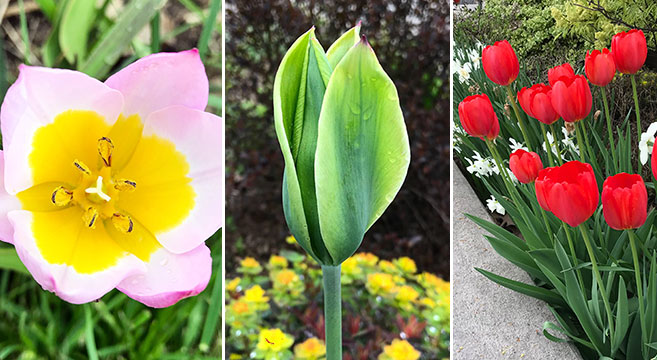This post may contain affiliate links. If you make a purchase through links on our site, we may earn a commission.
I used to think that all tulips came back every year. Pretty much every bulb I had ever planted would reappear each spring. In the house I currently live in, I had a few dependable bulbs that would bloom in my front garden. However after a few years, I noticed some were only producing leaves. It turns out that flower production ebbs in certain types of tulip. If you want your bulbs to bloom each year, you need to look for perennial tulips.
Choosing perennial tulips
Technically all tulips should be perennial. However years and year of hybridizing, not to mention the fact that our North American conditions do not align with those where tulips originate, means that for some types, the bloom reliability will wane. Also, there are many tulips that have been bred for the cut flower industry. The focus for those has been on producing one big beautiful bloom on a strong stem. Grow once, dig up the bulbs and start over next year.

If you want your tulips to come back each year, there are some clues that will help you when putting together your bulb order. Look for the words “naturalizing,” “species,” and “perennializing,” as you scan through the tulip selection at the store, in a catalogue, or online. Those words tell you they’re perennial tulips and not varieties that will only bloom once. The great thing about these bulbs is not only will they come back, they will multiply each year in the garden.
It’s important to note that species tulips are more diminutive in size. They are often called “dwarf tulips.” They may not stand tall enough for vases (unless you’re creating miniature arrangements), but I think their pretty faces are so cheerful and vibrant as they open in the garden.

There are also categories of tulips that will lead you to repeat tulip blooms: I’ve found Botanical, Viridflora, Darwin hybrid, Triumph, and Greigii are the ones most commonly found in lists.
Botanical tulips
These flowers, that are among the first to bloom in spring may be small, but they are mighty. Also called species tulips, these perennial tulips are deer resistant and naturalize really well in the garden. They may be mistaken for other flowers because they don’t have the same lithe shape of a traditional tulip, but these are the originals!
Look for these stunners: Peppermint Stick, Humilis Alba Coerulea Oculata, Tulipa acuminata, Tulip Tarda, and the two pictured in this article, Lilac Wonder and Pulchella Violacea
Viridflora tulips
It looks as though Mother Nature took a paintbrush dipped in green to add a unique flair to Viridflora tulips, one of the most unique perennial tulips. In fact, in Latin, viridis means green and flora means flower. Blooms are said to last longer on these.
Look for these beauts: Flaming Spring Green, Nightrider, and China Town
Darwin hybrid tulips
These big perennial tulips have that typical tulip shape and can grow up to 24 inches tall! Darwin hybrids are a result of a Dutch breeder crossing Red Emperor tulips with Darwin tulips. They make gorgeous cut flowers and bloom in mid to late spring.
Look for these showstoppers: Apricot Delight, Juliette, Pink Impression, and Ad Rem
Triumph Tulips
According to iBulb, the promotional agency for the flower bulb sector, Strong Gold is the most popular tulip variety. But there are also lots of other colours in this group, which is the largest group of tulips.
Look for these lovelies: Cairo, Jimmy, Arabian Mystery, and Flaming Flag
Greigii tulips
Greigii tulips are shorter in stature (but not as short as species tulips), but they make up for it with interesting blooms and foliage, which can be variegated.
Look for these standouts: Plaisir, Albion Star, Quebec, and Toronto
Planting perennial tulips in the garden
It’s important that you plant your bulbs as soon as you receive them in the mail or bring them home from the store. You don’t want them to dry out in your garage or shed!

Plant your tulip bulbs a bit deeper than recommended in full sun—about eight inches down. I use a special bulb-planting tool, like this one, to remove the soil and then a trowel to dig down more if I need to.
Like all flower bulbs, tulips prefer well-drained soil. The first year that you plant them, don’t worry about fertilizing your bulbs, as all the energy and nutrients they need to grow are contained in the bulb. Once you dig them in, water your bulbs to encourage root growth.
Once blooms are spent in the spring, deadhead the flowers themselves, but leave the foliage to die back on its own.

Protecting your perennial tulips from squirrels
There’s nothing more frustrating than seeing tulip bulbs sitting on top of the soil with bite marks. In my article on dealing with squirrels, I mention using hen manure to deter them from digging up your freshly planted bulb site. This worked for me last fall when I planted a mixed border of tulips and other spring-flowering bulbs. I planted them deeply and sprinkled Acti-Sol over the site and nothing disturbed them!

Learn about tulip planting depth in this article:
More fall bulb ideas
- Bulb-planting design ideas and tips from the Keukenhof
- Deer-resistant bulbs for spring colour in the garden
- Unusual flower bulbs for your garden
- When to plant daffodils




I don’t have trouble with squirrels eating the bulbs, but, I do have a lot of trouble with deer eating the leaves.
Hello Carol, I stumbled on this page & saw your comment— have you tried red chili flakes, chili powder, or bloodmeal? I have bunnies that eat my Muscari & Giant Crocus leaves. I thwart squirrels by interspersing daffodils with tulips, they’re toxic to squirrels, but I’m not sure about deer.